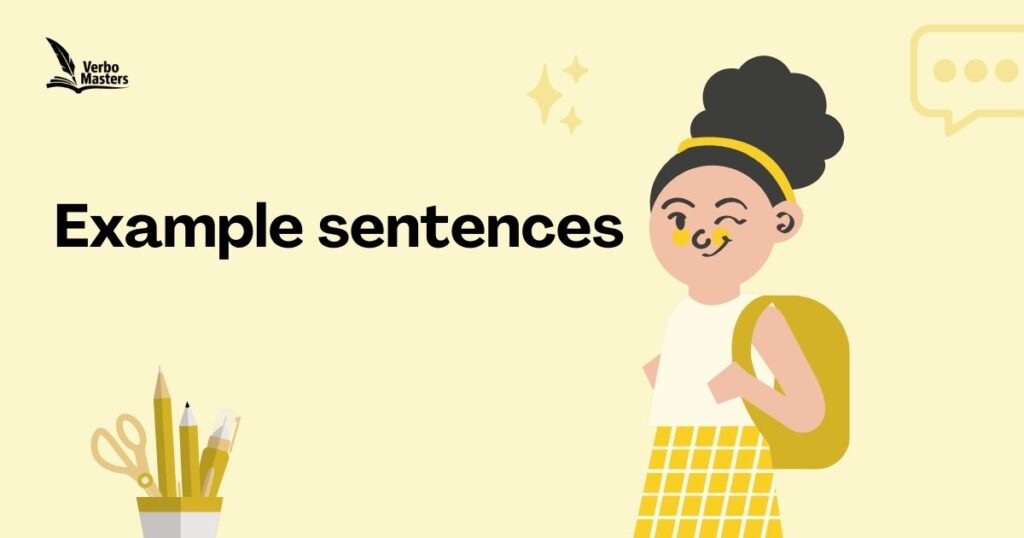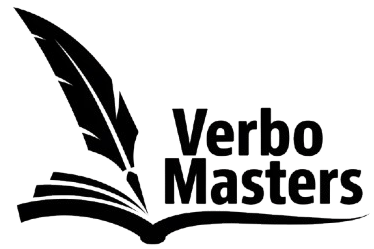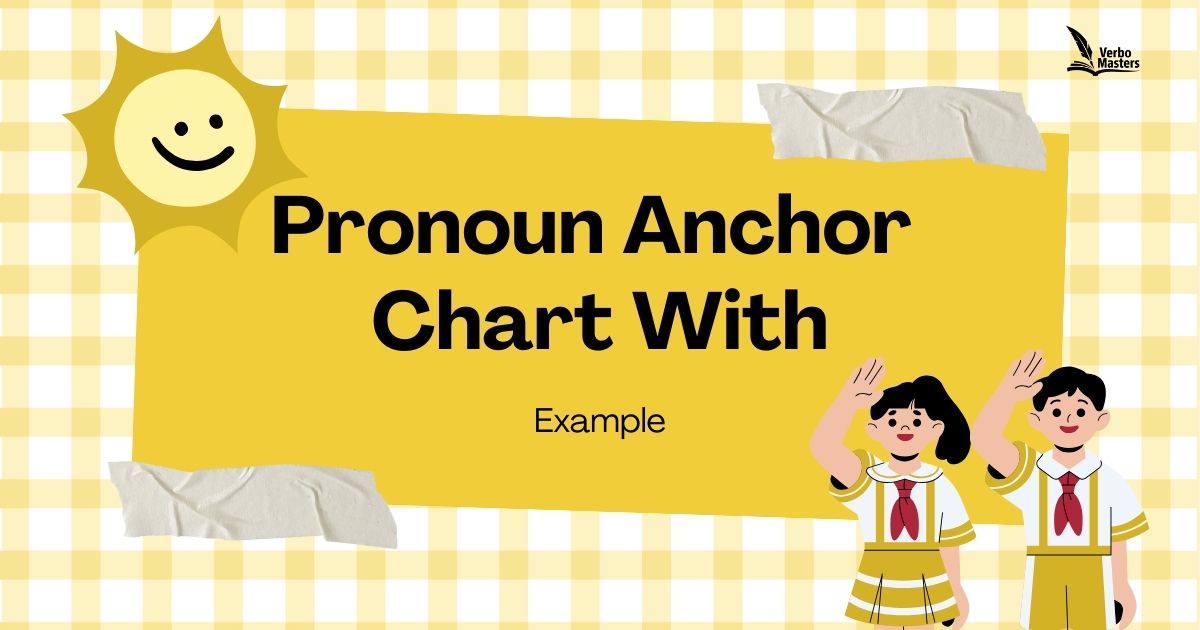Pronouns are words that take the place of nouns in a sentence. They help avoid repetition and make sentences smoother. Common pronouns include words like “he,” “she,” “it,” “they,” and “we.” For example, instead of saying “Sarah went to Sarah’s house,” you can say “She went to her house.”
Pronouns are essential for creating more natural and fluid conversations. They can refer to people, things, or ideas, depending on the context. Let’s look at some examples of pronouns in action!
You can also read; Preposition Example Sentences In English
Pronoun Anchor Chart
Pronoun Anchor Chart to cover the different types of pronouns with examples:
Pronouns
Pronouns are words that replace nouns in a sentence to avoid repetition.
Types of Pronouns:
1. Subject Pronouns
These pronouns act as the subject of a sentence. They perform the action.
- Examples: I, you, he, she, it, we, they
- Example Sentence: He is playing soccer.
2. Object Pronouns
These pronouns receive the action of the sentence.
- Examples: me, you, him, her, it, us, them
- Example Sentence: She gave me the book.
3. Possessive Pronouns
These pronouns show ownership or possession.
- Examples: mine, yours, his, hers, ours, theirs
- Example Sentence: This pencil is mine.
Singular vs. Plural Pronouns:
Singular Pronouns
These pronouns refer to one person or thing.
- Examples: I, you, he, she, it
- Example Sentence: She is reading a book.
Plural Pronouns
These pronouns refer to more than one person or thing.
- Examples: we, you, they
- Example Sentence: They are playing outside.
Additional Pronouns:
Reflexive Pronouns
These pronouns refer back to the subject of the sentence.
- Examples: myself, yourself, himself, herself, itself, ourselves, yourselves, themselves
- Example Sentence: I did it myself.
Demonstrative Pronouns
These pronouns point to specific things or people.
- Examples: this, that, these, those
- Example Sentence: These are my shoes.
Interrogative Pronouns
These pronouns are used to ask questions.
- Examples: who, what, which, whose
- Example Sentence: Who is at the door?
Indefinite Pronouns
These pronouns refer to non-specific things or people.
- Examples: everyone, anyone, no one, something, anything, nothing
- Example Sentence: Everyone is invited to the party.
Why Are Pronouns Important?
Pronouns make communication smoother by replacing repetitive nouns, making sentences shorter, clearer, and more efficient.
Example sentences

Example sentences for each type of pronoun:
Subject Pronouns
Subject pronouns replace the subject of the sentence.
- I am going to the store.
- You are my best friend.
- He loves playing soccer.
- She is reading a book.
- It is raining outside.
- We are planning a party.
- They went to the park.
- I like ice cream.
- You are very kind.
- He plays the guitar.
- She enjoys painting.
- It is a beautiful day.
- We have a meeting tomorrow.
- They are traveling to Paris.
- I am watching TV.
- You look great today.
- He is taller than his brother.
- She is studying hard.
- We are learning English.
- They are my cousins.
Object Pronouns
Object pronouns receive the action in a sentence.
- She called me yesterday.
- I saw you at the mall.
- He gave him a gift.
- Can you help her with homework?
- I told it to wait.
- She invited us to her party.
- They helped them with the project.
- I sent you an email.
- He asked me to help him.
- The teacher saw us in the hall.
- We greeted them with smiles.
- She showed it to her friend.
- I can’t find him anywhere.
- They asked us to wait outside.
- She made me a sandwich.
- Can you hear it clearly?
- I met her at the library.
- He gave me a book for my birthday.
- I saw them at the store.
- She called him for help.
Possessive Pronouns
Possessive pronouns show ownership.
- This book is mine.
- That pencil is yours.
- The house on the hill is his.
- The red bag is hers.
- The cake is ours.
- The decision was theirs to make.
- This is my car.
- Is that your dog?
- His shirt is blue.
- Her shoes are beautiful.
- That book is ours.
- The toys are theirs.
- This homework is mine.
- Is this coat yours?
- The painting is hers.
- The house is ours.
- The book on the table is mine.
- Is that laptop yours?
- The candy is theirs.
- The idea was ours.
Singular Pronouns
Singular pronouns refer to one person or thing.
- I am excited to go.
- You are very talented.
- He is going to the gym.
- She loves reading books.
- It is a sunny day.
- I want to play.
- You look nice today.
- He is my friend.
- She is wearing a red dress.
- It is too hot outside.
- I finished my homework.
- You are the best.
- He plays basketball.
- She is baking cookies.
- It is my favorite song.
- I am going for a walk.
- You should come with me.
- He helped me fix the car.
- She enjoys painting.
- It is a great movie.
Plural Pronouns
Plural pronouns refer to more than one person or thing.
- We are going to the beach.
- You all need to be quiet.
- They are having a party.
- We have a lot of homework.
- You are my best friends.
- They are planning a trip.
- We can do it together.
- You need to be careful.
- They like to play soccer.
- We enjoy going hiking.
- You all are invited to the wedding.
- They are very friendly.
- We have two dogs.
- You all need to study.
- They went to the movies.
- We are excited for the weekend.
- You are the best team.
- They always help us.
- We like to eat pizza.
- They are traveling to Italy.
All Pronouns
These are all types of pronouns (subject, object, possessive, singular, and plural) used in different contexts.
- I saw you at the store yesterday. (Subject + Object)
- She loves her new shoes. (Subject + Possessive)
- We are playing with them. (Subject + Object)
- It is mine. (Subject + Possessive)
- They went to the park with us. (Subject + Object)
- This is my car, and it is mine. (Possessive + Subject)
- He told me his secret. (Subject + Object)
- I am taking it home. (Subject + Object)
- She is talking to him about his project. (Subject + Object + Possessive)
- This book is hers, but they took it. (Possessive + Subject + Object)
- We enjoyed our trip to the zoo. (Subject + Possessive)
- You should bring it to me. (Object + Subject)
- He gave her his old shoes. (Subject + Object + Possessive)
- They went to the party with us. (Subject + Object)
- I can help you with your homework. (Subject + Object + Possessive)
- The cookies are mine, but they ate them. (Possessive + Object)
- We shared our ideas with them. (Subject + Possessive + Object)
- She asked me to bring her books. (Subject + Object + Possessive)
- They are sitting by me. (Subject + Object)
- It is yours if you want it. (Subject + Possessive)
FAQ’s
What is a pronoun?
A pronoun is a word that takes the place of a noun to avoid repetition. It helps make sentences simpler and clearer.
Why are pronouns important?
Pronouns help avoid repeating the same noun over and over in a sentence, making the language smoother and easier to understand.
Can a pronoun be used at the beginning of a sentence?
Yes, pronouns can be used at the beginning of a sentence, often as the subject. For example, “He is coming to the party.”
What are subject pronouns?
Subject pronouns are pronouns that function as the subject of a sentence. Examples include “I,” “you,” “he,” “she,” “it,” “we,” and “they.”
What are object pronouns?
Object pronouns receive the action in a sentence. Examples include “me,” “you,” “him,” “her,” “it,” “us,” and “them.”
What are possessive pronouns?
Possessive pronouns show ownership or possession. Examples include “mine,” “yours,” “his,” “hers,” “ours,” and “theirs.”
How do reflexive pronouns work?
Reflexive pronouns refer back to the subject of the sentence. Examples include “myself,” “yourself,” “himself,” “herself,” and “themselves.”
What are plural pronouns?
Plural pronouns refer to more than one person or thing. Examples include “we,” “they,” and “you” (when referring to multiple people).
Can a sentence have more than one pronoun?
Yes, a sentence can have multiple pronouns, each serving different functions. For example: “I gave him my book.”
What is the difference between “its” and “it’s”?
“Its” is a possessive pronoun, meaning “belonging to it.” “It’s” is a contraction for “it is” or “it has.”
Conclusion
Pronouns are words used to replace nouns in a sentence. They help avoid repetition and make sentences clearer and easier to understand. Some common examples of pronouns include “he,” “she,” “it,” and “they.” Without pronouns, we would constantly repeat the same nouns, which would make communication clunky and less fluid.
Understanding how to use pronouns correctly is essential for clear writing and speaking. They help create more concise and effective sentences. By mastering pronouns, we can improve the flow of our sentences and make our language more natural. So, make sure to practice using pronouns to sound more confident in your communication!

I’m John Smith, a language enthusiast dedicated to helping writers, students, and professionals master the art of clear and effective communication. Whether you’re looking for grammar tips, writing guides, or common mistake corrections, you’ll find valuable insights to improve your language skills. Let’s make grammar simple and fun!

